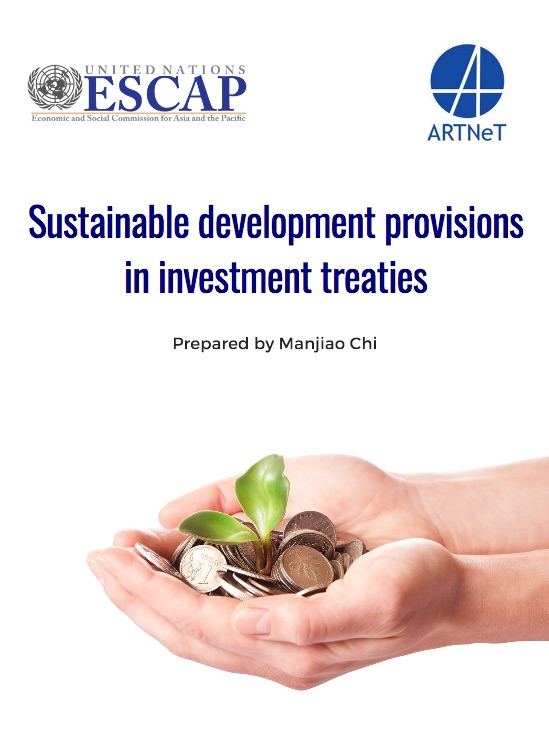Sustainable Development Provisions in Investment Treaties

Foreign investment has been and still is an important factor for the economic development of many countries, especially developing countries. Transnational investment activities bring about the needed capital and technology to the host states, but they may also give rise to sustainable development concerns, such as environmental and labour rights concerns. To many developing countries, such concerns could be particularly profound.
Transnational investment activities are not only subject to the domestic laws of the host states, but they are also governed by a large number of international investment agreements (IIAs), especially bilateral investment treaties (BITs) and investment chapters in the free trade agreements (FTAs). In light of such a background, there appears a growing call that IIAs should be made sustainable development-oriented. In other words, IIAs should not only serve the purpose of protecting foreign investors and their investments, but they should also play a facilitative and promoting role for the contracting states in pursuing sustainable development. In recent years, many countries, especially developed countries and emerging economies, have put growing emphasis on sustainable development in negotiation of the IIAs.. While it is premature at this point of time to conclude that making sustainable development-oriented IIAs has become a global trend, it is natural for Asia-Pacific countries, including least developed countries (LDCs) and landlocked developing countries (LLDCs), to take note of this emerging trend in IIA-making.
In assessing whether and to what extent an IIA is sustainable development-oriented, the number, types and subtypes of sustainable development provisions (SDPs) contained in this IIA are analysed. To some extent, the number of SDPs contained in an IIA demonstrates whether the IIA incorporates any treaty norms that can be used in addressing sustainable development concerns; the types of SDPs show what kind(s) of sustainable development concerns the IIA can address; and the subtypes of SDPs further explains the practical effectiveness of the IIA in addressing sustainable development concerns.
While adopting the above-mentioned analytical approach, this report investigates, analyses and compares the SDPs incorporated in the selected 20 sample IIAs and those contained in the 340 BITs of eighteen Asia-Pacific LDCs and LLDCs. Such study reveals that the sustainability gap between the two groups of IIAs is substantial. Compared with the sample IIAs, BITs of Asia-Pacific LDCs and LLDCs not only contain smaller number of SDPs, but these SDPs are also of less types and subtypes. This suggests that BITs of Asia-Pacific LDCs and LLDCs are less sustainable development-oriented than the sample IIAs in general. Furthermore, the comparative study of the types and subtypes of the SDPs of the two groups of IIAs also suggests that, as BITs of Asia-Pacific LDCs and LLDCs contain less social SDPs and allow narrower access of non-state stakeholders to engage in investment governance, they appear less socialized and governance-oriented than the sample IIAs.
There could be various reasons to explain the sustainability gap between BITs of Asia-Pacific LDCs and LLDCs and the sample IIAs. This study reveals that Asia-Pacific LDCs and LLDCs in general adopt the traditional and original perspective of sustainable development. Though sustainable development traditionally and originally stands for a bi-dimensional paradigm of balancing economic growth and environmental protection, it has been materially expanded in recent years. Today, it is widely agreed that sustainable development has gained a third pillar, i.e. social development. The inclusion of a social dimension not only enriches the contents of sustainable development, but more importantly, it also helps transform sustainable development from a bi-dimensional paradigm to a multi-dimensional paradigm that tries to strike a proper balance among economic growth, environmental protection and social development. Reflected in IIA-making, the expansion of sustainable development implies that more types and subtypes of SDPs should be incorporated in IIAs.
While recognizing that concluding sustainable development-oriented IIAs is a sensible policy option and an emerging trend for countries in confronting sustainable development challenges, it does not necessarily mean that an IIA with a high level of sustainable development-orientation is suitable for all countries or that such an IIA can best serve the development goals of a country. As the survey result shows, Asia-Pacific LDCs and LLDCs not only face different levels and types of sustainable development challenges, they also have different policy preferences and national situations. Such differences imply that no one-size-for-all model of sustainable development-oriented IIA exist for all Asia-Pacific LDCs and LLDCs. Rather, these countries should formulate or improve their respective IIA-making strategy with a suitable level of sustainable development orientation. Such a strategy needs to be based on an assessment of their respective national situations and sustainable development challenges, with necessary reference made to the existing IIAs that are deemed sustainable development-oriented.
